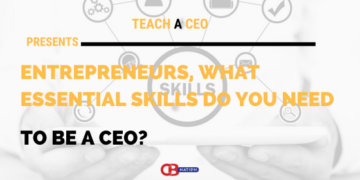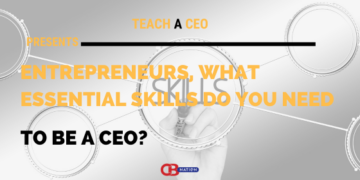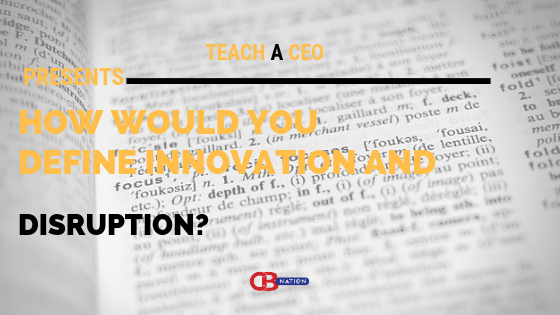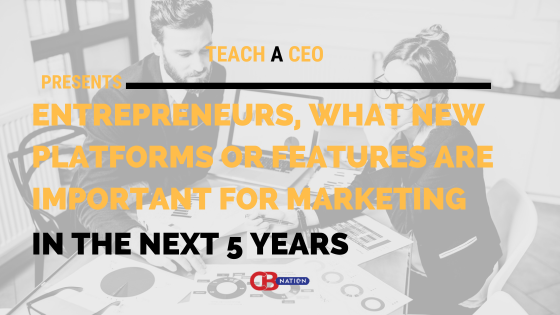Improvement in technology is driving disruption across almost every industry even those that are considered traditional. It's reducing existing barriers to entry and makes it much easier for small businesses to challenge established ventures.
An example of the disruption happening across industries is the use of artificial intelligence.
Here's what entrepreneurs had to say about the disruptions happening in their industries.
#1- Machine learning

The biggest disruption I see in the eCommerce sector is definitely machine learning. Companies that are utilizing machine learning to make shopping a more personalized experience are leaving the competition in their dust. With machine learning, you can properly identify what sells and what works depending on many variables such as traffic source, time of day and region of the world the shopper is in. I truly believe that companies that ARE NOT utilizing AI, big data and machine learning will start to fall by the wayside and become obsolete in 5ish years.
Thanks to Devin Zander, SMART Apps!
#2-Formalized CSR initiatives

Today’s companies are being reshaped by rapidly changing consumer and employee demands, declining levels of consumer trust, and increasing expectations to make a positive impact on society, the environment, and local communities. Companies investing time and resource allocation to formalized CSR initiatives are outperforming their competitors. Creating structure around these initiatives has several business benefits including increased employee retention, attracting top talent, and increased brand valuation. CSR programs have been a part of corporations for years, but as competition for customers and talent increases, they’re becoming more and more influential.
Thanks to Joe Givinga, Givinga!
#3-Bitcoin and Cryptocurrency

In the finance industry, Bitcoin and Cryptocurrency, in general, are major players in disrupting the banking industry. Bitcoin was designed to be peer to peer without the need for banks or other financial institutions as intermediaries. It isn’t here to “Fit In” with the financial system, but rather to provide an alternative to the traditional banking system. New technologies have a way of leapfrogging or jumping over older technologies. Anyone with a mobile phone with internet access can have a bank in their hands. By using Bitcoin, they can enter the global financial markets, without ever having access to traditional finance models.
Thanks to Mark Moss, Market Disruptors and Signal Profits!
#4- Two disruptions

Facebook and Google are making moves that could indicate that media buying is no longer going to be a competitive advantage and is much more accessible to your everyday advertiser. In many traditional agencies media buying is it's own distinct role where the creative team hands off assets to a media buyer who then decides which specific assets will go where, judges the performance of ads, and redeploys ad spend appropriately to higher performing ad platforms. This process often has been vague and opaque to many advertisers and this they've relied on media buyers to navigate the nuances of bidding, optimizing, and targeting audiences. Now, Google is testing out a a CPA model (cost per action) and Facebook has been heavily deploying machine learning into it's ads manager that does most of the heavy lifting around audience targeting and optimization. Both these moves are emphasizing the importance of creative assets over media buying savvy and, it's my prediction, that your average advertiser won't need a dedicated media buyer on these platforms. One marketer with even basic knowledge of setting up and deploying ads will be able to effectively manage the entire process.
Thanks to Jeromy Sonne, FirmFuel!
#5- Ability for an everyday person to build their own website

One of the largest disruptions taking place in our industry is the ability for your everyday person to build their own beautiful website. In fact, most websites that are build today, do not need an agency at all. People need imagery, great copy and an eye for design, and they can build it on their own with wix, shopify & squarespce. While agencies have provided the “service factor as well, this is now being made redundant by companies like b12 dot io who are happy to set up your website for as low as $150. (and incredible deal, for beautiful work). Web design agencies will need to step up their service game or shift their model to become more profitable on smaller margins and leverage existing technology. Most clients don’t need a glitzy site, just one that reflects their brand in an engaging way. The look on a client's face when you save them 12k and 2 months by using a beautiful template? Priceless
Thanks to Yossi Chanowitz, a small agency!
#6- Smart Phone Cameras

The photography industry is constantly disrupted by new technology. Being a photographer today means being very adaptable to learn new tech quickly. When I entered the industry in 2004, we were still asking questions about the quality and archival ability of digital photographs, and photographers who had been working in film over the last century were aging out of the ability to adapt to digital photography formats. The current disruption is Smart Phone Cameras eliminating the need for DSLR Cameras and Point & Shoot Mirrorless Digital Cameras for amateur photography enthusiasts. The lens and image tech in the latest phones are so good for travel and hobby purposes that people don’t feel the need to invest in or carry a separate camera any longer- they just need the highest quality phone camera to take 90% of the images they used to take with much more expensive and bulky gear. Phones make more ideal travel cameras because they fit in pockets, don’t require separate batteries or lenses, can now be waterproof, and make the majority of images people want to take quick, accessible, and easy to share online.
Thanks to Anne Ruthmann
#7-AI and/or Machine learning
Hiring industry is one of the great old industries, that hasn’t seen too much of disruption in the last 100 years. Up until now. Startups and corporations are really disrupting the hundred year old model of placing job ads, in the newspapers, as door signs, or in the last 20 years on the web. More and more, businesses are trying to match with the best candidates using AI and/or Machine learning algorithms. We believe that the future holds much more disruption, then what we have seen until now, as candidates are becoming a rare breed, and the demand for them is on a steady rise. Geolocation, skill based matching, or even paycheck matching, is something that the candidates want, so they can have more flexibility and more options to chose from, so the businesses need to find a new way to source those candidates by using disruptive technologies.
Thanks to Nemanja Stefanovic, HireApp!
#8-SD-WAN

In the telecom industry currently, SD-WAN (the new buzz term) is disrupting it all. If you are a business with Internet, you will come across it soon. Before, you had to choose, and now you can have it all. These days, everyone wants things fast. Fast cars, fast smartphones, fast food, fast Internet speed, and fast data loading speed. The computing has evolved over time, and it leads to a disruption in the network capabilities. As a result, enterprises and businesses are now looking for the best solution to get rid of the reduced network speed and poor performance. That’s where SD-WAN (Software-Defined Wide-Area Network) comes into the picture. SD-WAN,a term you will see popping up everywhere, is the latest solution that can improve performance reliability, business agility, Internet economics and offers many more benefits to the businesses. It connects the business networks, including their data centers and branch offices, over vast geographical distances. You no longer have to limit yourself in your telecom and Internet decisions.
Thanks to Dominic Serra, Metro Wireless!
#9- Voice-based user interfaces

A big disruption in the industry of my work (UX design & software development) is voice-based user interfaces, which is basically any interface that doesn’t have a graphical component to it. This is a technology that is globally expanding; in 2019, many American’s use a VUI (voice user interface) on a daily basis. These voice-activated devices are becoming more and more popular for consumers, especially since so many people now have access to them. Siri is pre-installed on iPhones, and the Amazon Echo Dot can be purchased for around $20. There is no doubt that VUI technology is accessible, affordable, and user-friendly, hence its increasing popularity. While people typically used Siri, Alexa, or the Google Home to find information about time, news, weather, or music, people are starting to use them to find more intelligent answers. On top of consumers adopting this technology, businesses are starting to adopt it as well. Alexa for Business is a great example of this; a VUI service that enables businesses and employees to use the technology to be more efficient in their work. While it may seem that VUI’s are still a newer technology, they are absolutely disrupting the world of tech.
Thanks to Keval Baxi, Codal!
#10- App-ordering and delivery services

I am constantly faced with ever-changing disruptions in the restaurant industry that directly effects the strategy used for my restaurant clients. One of the biggest current disruptions to the restaurant industry is the rise of app-ordering and delivery services (*i.e. DoorDash, Caviar, UberEats, PostMates, etc.*). This has been both a positive and negative addition to the restaurant scene – while they are introducing restaurants to new guests and serve as a great discovery platform throughout the city, those guests remain the customer of the delivery service (not the restaurant) and therefore disrupts the restaurant's ability to further connect with customers and promote brand loyalty. Additionally, with already tiny profit margins, restaurants are forced to share anywhere between 15-25% of the sales with the 3rd party delivery apps, putting restaurants in an incredibly difficult financial position. However, due to the app's ever-increasing popularity, many restaurants have started to rely on these services to help them survive – creating an almost parasitic relationship.
Thanks to Amanda Lewis, AGL & Co.!
#11- A number of disruptions

Startups do shape the future, and the transportation industry is not immune from them. They offer more innovative transport means every day. Ridesharing, affordable cabs, bus-pooling and even scooter-sharing are offering less expensive and accessible rides by remodeling the public perception of transportation. Our target market gets squeezed daily and we do feel the fierce impact of the ever-tightening competition. Disruption: greater selection causes lower prices, which gradually becomes a stronger motivator for choice than the service quality. Nevertheless, we still have our consumer group who still values personal relationship and individual service more than low prices. We have been growing at a whopping 100% rate since Uber arrived – growing in new cities as we go. Tech has changed the norm. In 2012 85% of our website traffic was coming from a desktop, in 2019 it’s 50%. In 2012 guests would book several days in advance, now they do several hours before. Disruptions will progress, but so the crowd still wanting to hear the human voice first on the other end of the line.
Thanks to Davit Zakaryan, DCAcar!
#12- Flexible working

The biggest disruption to the commercial property industry has undoubtedly been flexible working. Coworking spaces and flexible offices are completely taking over. The number of square feet that flexible workspace providers are taking up across major cities is staggering. For years, companies would have to sign long and inflexible leases in order to acquire office space. Nowadays, they can pay a monthly contract and take space in a serviced office or coworking space. This has given organizations the freedom to choose space that suits them right now whilst also giving them the option to move straight away if their setup grows.
Thanks to Nick Riesel, FreeOfficeFinder!
#13- Intersectionality between retail and healthcare
 The most interesting disruption in my industry is the intersectionality between retail and healthcare. Today, healthcare represents a multi-billion-dollar opportunity for companies due to high levels of customer dissatisfaction, growing costs, and a lack of accessibility for many. With such a large opportunity, and the emphasis successful retailers place on customer experience, business leaders see a growing opportunity to enter this space to fill the market void. Among examples of traditional retailers entering this space: Walgreens is partnering with Humana to build out new services in existing stores in Kansas City, Best Buy purchased Great Call for $800M last year, and Amazon has partnered with Berkshire Hathaway and JP Morgan to create a new health offering. We anticipate the intersection of retail and healthcare to be a key disruptive trend that shapes 2019 and the subsequent years because of the new, untapped potential it presents for retailers to expand into a new market.
The most interesting disruption in my industry is the intersectionality between retail and healthcare. Today, healthcare represents a multi-billion-dollar opportunity for companies due to high levels of customer dissatisfaction, growing costs, and a lack of accessibility for many. With such a large opportunity, and the emphasis successful retailers place on customer experience, business leaders see a growing opportunity to enter this space to fill the market void. Among examples of traditional retailers entering this space: Walgreens is partnering with Humana to build out new services in existing stores in Kansas City, Best Buy purchased Great Call for $800M last year, and Amazon has partnered with Berkshire Hathaway and JP Morgan to create a new health offering. We anticipate the intersection of retail and healthcare to be a key disruptive trend that shapes 2019 and the subsequent years because of the new, untapped potential it presents for retailers to expand into a new market.
Thanks to Carlos Castelán, The Navio Group!
#14- Automated robots

We are in the forklift rental and leasing industry. One of the disruptions that I see are automated robots that easily replace forklift drivers and forklifts. These robots are not only more affordable than hiring manual workers, they are also more efficient with the ability to keep going for 9 hours straight with just one hour of charging. This will greatly help with any heavy lifting of pallets and bulky cargos. As a forklift company, we are threatened by the emergence of such technologies.
Thanks to Shawn Lim, Singapore Forklifts!
#15- 5G

The coming of 5G is likely to be the greatest source of disruption to many industries, as it will enable data delivery that exceeds the supportable bandwidth on current LTE networks. With 5G, bandwidth intensive services can be delivered with less concern about wireless network limitations. For example, when we think of videomatics for fleet management, services offered currently are more event-driven rather than streaming. 5G will offer users the ability to quickly process more data to support real-time
activities at a much more reasonable cost.
Thanks to Keith Schneider, GPS Trackit!
#16-Frauds devastating the online coupon business

In this digital age, a big number of online shoppers search for online coupons even before searching their desired product online. This immense popularity of online discount coupons has brought extreme competition in this industry. Eventually frauds have invaded the industry with fake, used and expired coupons. Most of the customers who are cheated by these unusable coupons and failed to get their desired discounts express their logical grudge publicly in their online reviews. These unfortunate incidents and negative reviews are heavily damaging the credibility of so many brands and merchants. Moreover, due to multiple occurrences of these incidents, a number of reputed brands are losing interest in online coupon system.
Thanks to Andrei Vasilescu, DontPayFull!
#17- Complexity of digital commerce

Digital commerce continues to grow and evolve at a rapid rate. Consumers and businesses alike are buying more and more of the products and services they want and need through digital devices. The growth of digital commerce is creating previously unimaginable convenience, efficiency, and value. It’s also creating the need for an increasingly sophisticated set of capabilities to maximize value and minimize negative disruption. Leading digital commerce companies recognize the need for great underwriting, fraud prevention, and fraud detection tools and practices, and regulatory efforts such as GDPR and PSD2 ensure that each participant in the digital commerce value chain is aware of the need for solid data and privacy protection. A number of emerging technologies will influence the development of digital commerce, especially Artificial Intelligence (AI), block chain, and voice assistants. Each will likely play a role, but how big that role will be and how quickly each will become a meaningful contributor to the bottom line remains to be seen. An increased focus on taxation in many parts of the world has made tax management an increasingly important part of digital commerce, and the ability to conduct transactions in local currencies and languages is becoming a prerequisite. The ability to combine great invoicing, subscription management, tax management, foreign exchange, and payment flexibility in one place is also becoming increasingly important as digital commerce providers compete to change their industries around the globe. Today most providers stitch a bunch of disparate systems together to get the capabilities they need, but next generation platforms that simplify the increasingly complex set of digital commerce needs are gaining ground, becoming the ultimate disrupters.
Thanks to Alex Hart, 2Checkout!












































 |
|
Correction: Photo Credit for Anne Ruthmann portrait goes to Brian Wright at http://www.allredstudio.com
Anne. This is updated